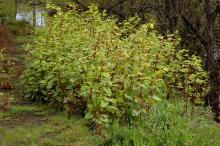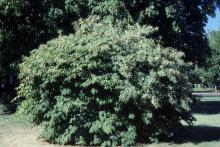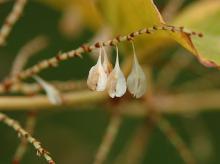Polygonum cuspidatum
Common name:
Japanese Knotweed
Mexican Bamboo
Pronunciation:
po-LI-go-num cus-pi-DA-tum
Family:
Polygonaceae
Genus:
Synonyms:
Fallopia japonica var. japonica
Fallopia japonica
Polygonum japonicum
Type:
Broadleaf
Native to (or naturalized in) Oregon:
No
- Deciduous perennial, tough, vigorous, spreading rapidly from rhizomes to form very large clumps of red-brown jointed, and hollow stems (bamboo-like), 4-8 ft (1.2-2.4 m) tall. Leaves alternate, simple, 5-7.5 cm wide, heart-shaped with rounded lobes at the base, vein often reddish, upper surface dark green, paler green below; petioles ridged and 2.5 cm long. Mostly dioecious -- i.e., male and female flowers mostly on separate plants. Flowers appear in late summer or fall, they are small greenish or cream white and in elongated clusters, 10-13 cm long. Fruit has a three-winged calyx and contains a single seed, which is dark brown, triangular and 2-4 mm long and 2 mm wide.
- Sun to shade. Grows best on moist, well-drained, nutrient rich soil but tolerates adverse conditions. The above ground parts of plants die with the first fall frost, but rhizome buds over winter just below the soil surface and form new shoots in spring.
- Hardy to USDA Zone 4 Native to Japan, China, and parts of Korea and Taiwan. It was introduced to the United States prior to 1890.
- A variegated, 'Variegata' from is available:
- Taxionomic confusion: "The taxonomy and nomenclature of Japanese knotweed have changed often over time, resulting in references to it in three genera: Polygonum, Reynoutria, and Fallopia. These many names are the result of a history of confusing taxonomy. In 1777, material brought from Japan was named Reynoutria japonica and then in 1846 additional plant material from Japan was named Polygonum cuspidatum by Siebold and Zuccarini. Only in 1901 was it discovered that the two plants were identical (Beerling et al. 1994). Taxonomic confusion continues today as in North America the official Latin name is Polygonum cuspidatum while in the British Isles it is Fallopia japonica" (Univ. Wisconsin, Weed Science, 1998). The acceted name by the ITIS is Fallopia japonica var. japonica.
- A very invasive plant, a weed. In the 1960s it was listed as "one of the most persistent and aggressive of all perennial weeds". The plant was and is still used as a landscape and garden ornamental. Through this activity it has spread across the United States and occurs from the Northeastern states to California, as well as in Nova Scotia, Newfoundland, Canada. It is a significant weed in Britain, Europe and Russia, and most of Asia also reports having Japanese knotweed. The spread of Japanese knotweed has been swift and unstoppable. Not only an issue in the United States, "the eradication of this weed has stumped many a farmer, gardener, and herbicide in many countries." (Doll and Doll, 1998, Univ. Wisconsin).











